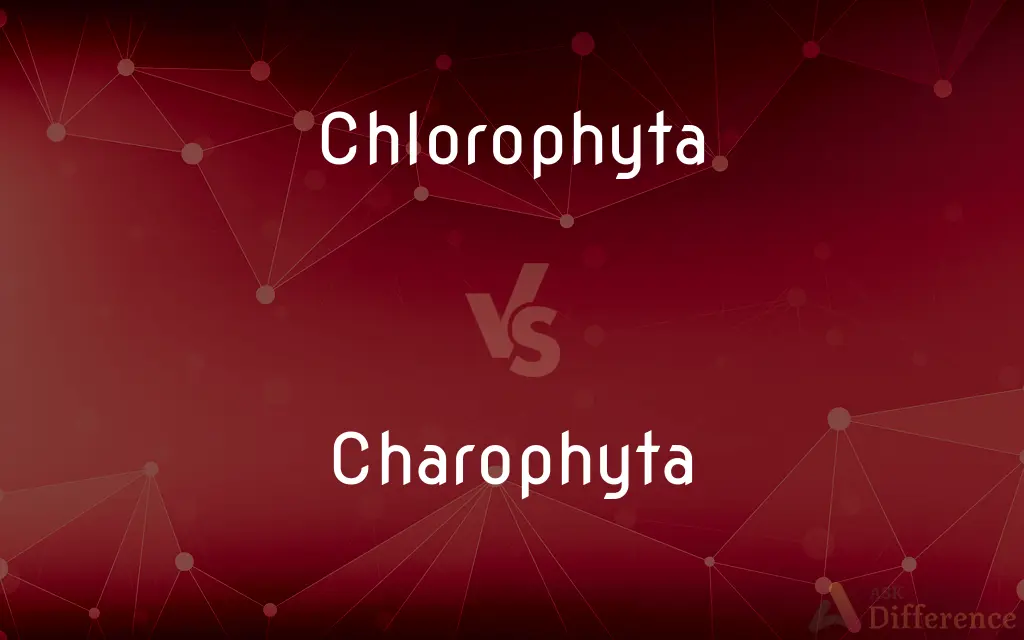Chlorophyta vs. Charophyta — What's the Difference?
By Tayyaba Rehman — Updated on October 30, 2023
Chlorophyta are green algae in freshwater/marine habitats, while Charophyta are green algae closely related to land plants.

Difference Between Chlorophyta and Charophyta
Table of Contents
ADVERTISEMENT
Key Differences
Chlorophyta, commonly known as green algae, are predominantly found in freshwater and marine environments. They are known for their diverse forms, ranging from unicellular to multicellular structures. Charophyta, on the other hand, are a distinct group of green algae that are closely related to land plants and are often found in freshwater habitats.
The cell structure of Chlorophyta is relatively simple and similar to other algal groups. They possess chlorophyll a and b for photosynthesis. Charophyta, in contrast, show a more complex cell structure and possess chlorophylls similar to those in higher plants, indicating a close evolutionary relationship.
Reproduction in Chlorophyta can be both sexual and asexual, with some species exhibiting complex life cycles. Charophyta also reproduce sexually and asexually, but their reproductive structures are often more advanced and similar to those of land plants, showcasing their evolutionary link.
Chlorophyta are ecologically significant in aquatic ecosystems, contributing to oxygen production and serving as a food source for aquatic life. Charophyta play a crucial role in the transition of plants from water to land, providing insights into evolutionary biology.
In terms of application, Chlorophyta are used in various industries, including biofuel production and as dietary supplements. Charophyta, due to their unique properties, are studied extensively in evolutionary biology and plant sciences.
ADVERTISEMENT
Comparison Chart
Habitat
Mainly freshwater and marine environments.
Predominantly freshwater habitats.
Cell Structure
Simpler cell structure with chlorophyll a and b.
More complex cell structure, closer to land plants.
Evolutionary Significance
Diverse group with less direct relation to land plants.
Closely related to land plants, key to understanding evolution.
Reproductive Structures
Varied reproductive structures, both sexual and asexual.
More advanced reproductive structures, akin to land plants.
Ecological and Industrial Role
Important in aquatic ecosystems, used in biofuel and food.
Studied in evolutionary biology, insights into plant evolution.
Compare with Definitions
Chlorophyta
Aquatic organisms with chlorophyll for photosynthesis.
The Chlorophyta in the lake contribute to its vibrant green color.
Charophyta
Freshwater green algae significant in evolutionary studies.
Charophyta are extensively studied to understand the origin of land plants.
Chlorophyta
Algae ranging from unicellular to multicellular forms.
Some Chlorophyta species form large seaweeds in the ocean.
Charophyta
Green algae closely related to terrestrial plants.
Charophyta provide key evidence for plant evolution from water to land.
Chlorophyta
Algae used in industries like biofuel and nutrition.
Certain Chlorophyta species are harvested for making dietary supplements.
Charophyta
Algae with chlorophyll and other pigments similar to higher plants.
The photosynthetic machinery of Charophyta is closely related to that of flowering plants.
Chlorophyta
A diverse group of green algae.
Chlorophyta are often seen as green scum on ponds.
Charophyta
Algae with complex cell structures and reproductive systems.
The reproductive structures of Charophyta resemble those of some early land plants.
Chlorophyta
Green algae contributing to oxygen production in water bodies.
Chlorophyta play a crucial role in the aquatic food chain.
Charophyta
Important organisms in understanding plant biology and evolution.
Charophyta are often used in scientific research to explore plant genetics and evolution.
Chlorophyta
Chlorophyta or Prasinophyta is a taxon of green algae informally called chlorophytes. The name is used in two very different senses, so care is needed to determine the use by a particular author.
Charophyta
The Charophyta (UK: ) or charophytes () is a group of freshwater green algae, sometimes treated as a division, but also as a superdivision, or an unranked clade. The terrestrial plants, the Embryophyta, most likely emerged within Charophyta, possibly from terrestrial unicellular charophytes, with the class Zygnematophyceae as a sister group.The clade Streptophyta is formed by the grouping together of the Embryophyta and the Charophyta.
Chlorophyta
Large division of chiefly freshwater eukaryotic algae that possess chlorophyll a and b, store food as starch, and cellulose cell walls; classes Chlorophyceae, Ulvophyceae, and Charophyceae; obviously ancestral to land plants
Common Curiosities
Do Charophyta exist in marine environments?
Charophyta are primarily found in freshwater, rarely in marine environments.
Can Charophyta survive on land?
Charophyta primarily live in water but some can survive in moist terrestrial environments.
Is Chlorophyta used in biofuel production?
Yes, some Chlorophyta species are used for biofuel due to their high lipid content.
Are Chlorophyta a source of oxygen in aquatic systems?
Yes, Chlorophyta contribute significantly to oxygen production in aquatic ecosystems.
Do Charophyta have a role in freshwater ecosystems?
Yes, Charophyta are important in freshwater ecosystems for oxygen production and as a food source.
Are Chlorophyta multicellular?
Yes, Chlorophyta can be unicellular, colonial, or multicellular.
Do Charophyta have a role in understanding plant evolution?
Yes, Charophyta are crucial for studying the evolutionary transition of plants from water to land.
Are Charophyta used in any commercial applications?
Charophyta are mainly used for scientific research rather than commercial applications.
Can Chlorophyta cause water pollution?
Excessive growth of some Chlorophyta can lead to algal blooms, which can be harmful to water bodies.
Do Chlorophyta have roots?
Chlorophyta do not have true roots; they may have root-like structures called rhizoids.
Can Charophyta live in harsh conditions?
Some Charophyta can survive in harsh conditions, but they generally prefer freshwater habitats.
Are Chlorophyta ancestors of land plants?
Chlorophyta are related to land plants, but Charophyta are more closely related.
Can Chlorophyta be found in aquariums?
Yes, some Chlorophyta species are common in aquariums and provide oxygen for aquatic life.
Are Charophyta used in genetic studies?
Yes, Charophyta are used in genetic studies to understand plant genetics and evolution.
Do Chlorophyta and Charophyta have different photosynthetic pigments?
Both have chlorophyll a and b, but Charophyta have additional pigments closer to those of land plants.
Share Your Discovery

Previous Comparison
Polymer vs. Elastomer
Next Comparison
Autopsy vs. NecropsyAuthor Spotlight
Written by
Tayyaba RehmanTayyaba Rehman is a distinguished writer, currently serving as a primary contributor to askdifference.com. As a researcher in semantics and etymology, Tayyaba's passion for the complexity of languages and their distinctions has found a perfect home on the platform. Tayyaba delves into the intricacies of language, distinguishing between commonly confused words and phrases, thereby providing clarity for readers worldwide.
















































